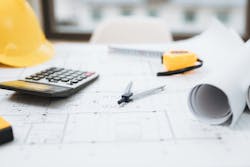Estimating is a challenge because there are so many types of projects in various sectors. The types of projects that estimators are expected to work on vary from one contractor to another. Some contractors focus on specific sectors where the company performs best. Others have the personnel and labor force to excel in various markets, such as residential housing units, commercial/institutional buildings, and industrial facilities. However, the skillset to estimate a water treatment plant is much different than estimating a commercial retail space.
A retail space involves lighting, convenient outlets, data communications, and possibly specialty lighting for product displays. A commercial project typically requires panels, transformers, luminaires, and special systems, including fire alarms. Whereas, a water treatment plant may require large distribution switchgear, generators, and variable-frequency drives (VFDs). The equipment needs are designed for a specific application and require a longer lead time due to the requirements in the specification.
When equipment quotations are received during the bidding process, there are always lead times noted in the “terms and conditions” of the quotation. These dates are subject to change based on the manufacturer’s production schedule as orders are received.
At this point, the estimator must be keenly aware of these specialty components and project schedule. The lead times of some major products can be an important factor in estimating the final bid price. The lead time is defined as the time it takes for a product or equipment to be delivered to the job site. Manufacturer delivery dates are always after an approved submittal has been received from the architect.
Once a contract is signed for a project, equipment is ordered but not manufactured. The supplier will provide shop drawings (i.e., submittals) to the contractor. The shop drawings are next provided to the architect for approval; then the equipment can be manufactured to the approved shop drawings. At this point, the manufacturer provides the contractor with an exact delivery date. Remember, the equipment must be delivered on time to allow for installation and commissioning before the contract completion date. In addition, extra manufacturing costs may be required to meet the project schedule. Some manufacturers do not even offer an expedited delivery service.
The estimator must carefully review the project schedule and the major pieces of equipment required. For example, some switchboards could have lead times as long as six months. The owner should be informed when the schedule and delivery dates are costly — or impossible — to execute.
Some custom-made architectural lighting products can also have long lead times. In certain cases, these items cannot be delivered promptly. When the owner has a fixed date to open their facility, the electrical contractor may be required to install temporary luminaires until the permanent lighting products are received. In these cases, additional labor and material will be required.
Here are my five most important takeaways to keep in mind when estimating with long lead time items.
- Review all major equipment quotations for delivery dates. The more sophisticated the equipment, the longer it takes to manufacture.
- Delivery times are always after engineer approval. Once the engineer receives the shop drawings from the contractor, he or she will carefully review every aspect of the equipment to ensure that it meets the specifications and will be built as specified. The more complex the equipment, the longer the approval process will typically be.
- Review the project’s construction schedule and phasing plan. If the project has a five-month schedule, delivery dates may become a challenge, depending on the equipment. If the project is completed in phases, the phasing plan must be reviewed to determine which pieces of equipment are in each phase. Different release dates will be required for the different phases of the project.
- Inform the owner when delivery dates and the project’s schedule are incompatible. It is in the best interest of both the owner and the contractor to resolve this conflict. Waiting for equipment can be disruptive to the contractor’s labor efficiency.
- Get any additional costs to expedite delivery in writing from the manufacturer’s representative. An owner may not even be aware that having to expedite the delivery of key components will increase the cost of their project. When the owner is unwilling to move the completion date, then these additional costs for expedited delivery must be included in the bid price.
Being aware of the project schedule, components, and lead times will allow for an accurate bid, a better relationship with the owner, and the most efficient installation. Proper handling of these long lead time items should increase profitability, which is the goal of every project.
About the Author
Don Kiper
Independent Electrical Estimating Consultant
With more than 35 years of experience as a construction electrician, industrial maintenance electrician, foreman, estimator, estimating manager, and project manager, Don has used what he learned to lead in the implementation of estimating software with three electrical contractors where he has worked. Don has 17 years of experience in the construction field and 18 years of office experience and he has personally estimated over $700 million dollars in electrical projects.
